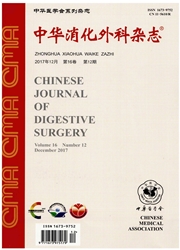

 中文摘要:
中文摘要:
目的 本研究旨在探讨肝上下腔静脉的不同重建方法对大鼠肝移植术后血流动力学的影响.方法 根据Kamada二袖套法、改良内覆静脉支架法和Harihara三袖套法3种不同的肝上下腔静脉重建方法将SD大鼠分为3组,每组先取12对记录手术成功情况、手术操作时间、术后1个月受体存活情况、肝脏弹性模量值、静脉血栓发生情况等.另以10只相近体质量大鼠作为对照组,测定其肝脏弹性模量值.利用激光散斑灌注成像(LS PI)监测3组移植组受体移植肝复流后和对照组肝脏的微循环.术后24,72 h和1个月,3组移植组各时间点再另取6只存活受体进行血流动力学参数检测.结果 二袖套组、支架组和三袖套组手术成功比例分别为12/12,11/12和11/12.术后1个月,二袖套组、支架组和三袖套组分别有11(11/12),9(9/11)和9(9/11)只受体存活,分别有0,7,4例发生静脉血栓;二袖套组发生静脉血栓比例低于支架组和三袖套组(P=0.000和0.026).二袖套组、支架组和三袖套组术后1个月和对照组肝弹性模量值分别为7.0±0.4,15.3 ±1.6,7.5 ±0.7和5.6 ±0.7,各移植组均高于对照组(F=209.70,P <0.05).移植肝复流后LSPI流量值逐步增加,但复流3,10,20 min后,各移植组间LSPI流量值差异无统计意义(F=1.96,3.81和1.65,P均>0.05);复流20 min时,各移植组LSPI流量值仍低于对照组(F =237.65,154.02和50.95,P均<0.05).将对照组大鼠血流动力学结果作为正常参考值,各移植组术后肝下下腔静脉(IHVC)和门静脉(PV)血流量、压力均逐渐升高.术后24,72 h和1个月,3组移植组大鼠IHVC和PV血流量均低于对照组,支架组最低(F=71.4和54.3,79.8和54.3,84.5和29.6,P均<0.05);3组移植组大鼠IHVC压力均高于对照组,支架组最高(F=73.5、159.8和110.1,P<0.05).术后24,72 h,二袖套组和三袖套组PV压力均低于对照组,而支架组高于对照组(F =126.6和193.5,P均<0.05).术后1?
 英文摘要:
英文摘要:
Objective To evaluate the effect of different suprahepatic vena cava (SHVC) reconstruction methods on the hemodynamics after liver transplantation in the rats.Methods Three rat liver transplantation groups were divided accodiing to the SHVC reconstruction methods:Kamada's two-cuff technique,a modified veno-lined stent technique,and Harihara's three-cuff technique.Ten rats of similar weight were grouped as control.Ultrasonic,hemodynamic parameters and the microcirculation of the liver were measured after transplantation.The detailed operation time,operative complications and animal survival were recorded.Results All the recipients showed portal hypertension one month after transplantation.The portal hypertension in the group with the modified veno-lined stent technique was the most severe.The value measured with real-time elastography was significantly higher in the recipients using the modified veno-lined stent technique than in the other two groups (F =209.70,P 〈 0.05).There was no difference in the graft microcirculation after reperfusion among the three groups.The survival rate was similar between the three groups.However,the modified veno-lined stent technique led to more venous complications than the other two techniques.Conclusions The hemodynamics after liver transplantation in rats is determined not only by the cuff used for portal vein reconstruction,but also by the cuff or stent for the SHVC.Some SHVC reconstruction methods,such as the modified veno-lined stent technique,Miyata's or Settaf's three-cuff techniques,significantly affect the hemodynamics.
 同期刊论文项目
同期刊论文项目
 同项目期刊论文
同项目期刊论文
 期刊信息
期刊信息
